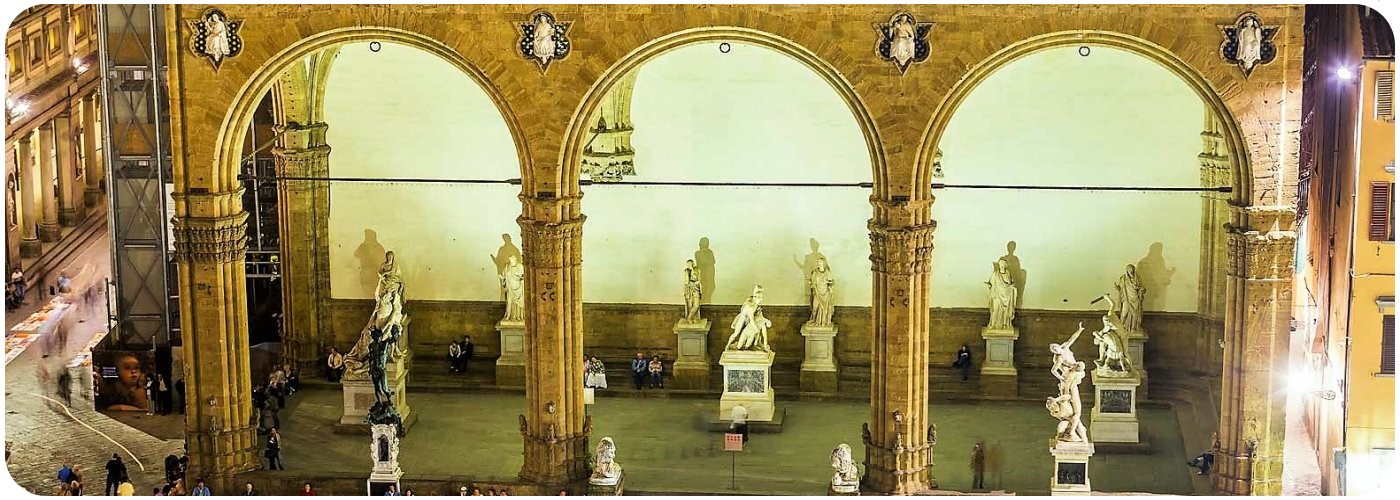The Loggia dei Lanzi
The Loggia dei Lanzi at its origins hosted public ceremonies and people's assemblies. From the terrace, the members of the Medici family attended the ceremonies in Piazza della Signoria.
The roof of the Loggia dei Lanzi was transformed into a terrace by Bernardo Buontalenti, after the construction of the Uffizi at the back of the Loggia.

The history of the Loggia dei Lanzi
The Loggia dei Lanzi was built between 1376 and 1382 by Simone di Francesco Talenti (who also worked for the Church of Orsanmichele) and Benci di Cione, even if for years it was thought to be designed by Andrea Orcagna (and for this reason called Loggia dell’Orcagna).
The name “Loggia dei Lanzi”, that is also known as “Loggia della Signoria”, comes from the period when the Grand Duke Cosimo I ruled over Florence: this place held the house of the so called Lanzichenecchi (landsknechts), German mercenary pikemen.
The architecture of the Loggia dei Lanzi
The Loggia dei Lanzi consists of some wide arches resting on clustered pillars with Corinthian capitals, open to the Piazza della Signoria and adjoining the Uffizi Gallery.The building is in contrast with the severe architecture of the Old Palace and is considered a clear example of an open-air sculpture museum of antique and Renaissance art.
Below the parapets on the façade of the Loggia dei Lanzi there are trefoils and the sculpture of the four cardinal virtues: Fortitude, Justice, Prudence and Temperance; they were realized by the artist Agnolo Gaddi. The four statues have a blue background with golden stars.
Antonio de’ Pucci realized the vault composed on semicircles and on the steps of the Loggia dei Lanzi there are the so called Marzoccos (originally located at Villa Medici in Rome), the heraldic lions that symbolize Florence.
On one of the side of the Loggia dei Lanzi there is a Latin inscription that commemorates the change of the Florentine calendar (which began on the 25th of March instead of the 1st of January) to the Roman one. The other inscription is about the annexation of Milan, Venice and Rome to the kingdom of Italy, whose capital at that time was Florence.

The sculptures of the Loggia dei Lanzi
In the Loggia dei Lanzi you can find an amazing variety of sculptures, among the most famous:
# Rape of the Sabine Women, realized by the Flemish artist Giambologna. This manneristic sculpture is in the Loggia dei Lanzi since 1583. It is considered the first group representing more than a single figure in the history of European sculpture, to be realized without a dominant viewpoint. The peculiarity of the sculpture is that it can be seen from all sides;
# Perseus, realized by the Florentine artist Benvenuto Cellini. This bronze statue represents the mythical Greek hero holding the head of the Medusa in his left hand and his sword in the right. It seems that Perseus is both reflecting and frightened by his action. On the marble pedestal Benvenuto Cellini realized four bronze statues representing the Greek’s Goods: Danae, Jupiter, Minerva and Mercurius;
# Menelaus supporting the body of Patroclus, an ancient Roman sculpture from the Flavian era. This group stood originally at the end of the Old Bridge and it was realized from a Hellenistic Pergamene of the mid third century BC.
During our walking tour we will stop at the Loggia dei Lanzi and our guides will explain the masterpieces in detail.
